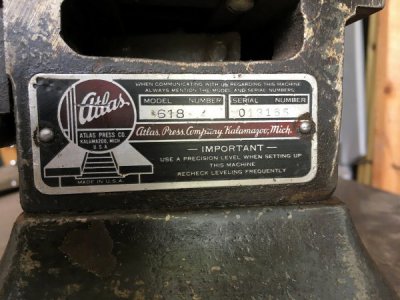Thanks! That's great information. The carriage moves smoothly and uniformly across its range. I also turned the other other wheels and the top and bottom wheels are smooth across the range; the middle one, with the oil reservoir beneath it, is stiff across its range.
Do you know what the "M 516" indicates? I've read that these are serial numbers, but I'm not sure what that means. Was each unit numbered, serially, or was this this some type of model #? Thanks again.
Edit: I'm also curious if anyone knows who the market was at the time for these smaller lathes. Who was buying these?
That's great that you've good consistent movement across the full extents. You may still need some maintenance parts--the half-nuts, M6-12A, the cross-slide nut, M6-19A, and compound nut, M6-306, are all made of softer material so that they wear out faster and preserve the mating screws for longer. BTW, note that part numbers that end with a letter (eg M6-12A), mean the part was redesigned during the production life of the machine. You could still have the older INCOMPATIBLE version. If you need to replace, do some research first...unlike me!
Sorry, but I don't know about the "M 516" mark. The serial number plate is normally on the tailstock end of the bed. Here is mine:

Unfortunately, the serial number doesn't tell us the date of manufacture. It is guesstimated that mine was made in the mid-to-late 1940s.
One of our members is a real Atlas historian and has examples of the marketing literature back in the day. These lathes were aimed at hobbiest users and small commercial operations. Mine came with a specialized tailstock that had soft jaws for holding the armature of an electric motor. There would have been another supplied gizmo to help recondition the armature. Presumably this would have been used in a local electric motor shop. Given the size of the lathe, it would have been limited to fairly small motors. Nowadays, it is not economical to do involved work like that on a small motor. Just buy a replacement. I think, however, it was said that Atlas sold about 90,000 6-inch lathes from the late 1930's to the early 1970's! I'm probably mis-remembering something, though.
I'm having a lot of fun with mine. I have no significant metalworking experience so I've been learning a tonne from these forums and from Youtube. (My wife may have muttered "obsessed" but I'm sure she wasn't talking about me!) My lathe needed significant repairs and restoration before I could use it. I completely disassembled it, cleaned, repainted and reassembled with replacement parts where necessary. Now, with sharp HSS tooling, it works quite acceptably. I recently discovered the joy of 'free machining steel'! As long as I'm patient, the machine is capable of quite a lot. OTOH, it is not going to turn replacement drive shafts for a D-12 Cat! I'm OK with that.

Craig


